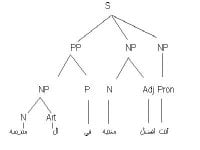chester_100
Member
- Joined
- Jan 9, 2008
- Member Type
- English Teacher
- Native Language
- Persian
- Home Country
- Iran
- Current Location
- Iran
I have to defer.
I do not understand.
As I have so often said, the American Reed-Kellogg system may be very simplistic, but it serves to analyze any sentence that makes sense.
As a contribution, I can offer to diagram any sentence in English, German, Portuguese, Spanish, or French. If a sentence in Arabic can be translated into any of these, I can diagram it.
Frank
That’s really a good idea. But the problem is that Arabic doesn’t follow the conventional Indo-European syntactic rules. For example, unlike English (or many other languages), the subject of the sentence may be implied, or shown through inflection.
In translation, we have to adapt it to English rules, so the sentence will undergo a transformation.

